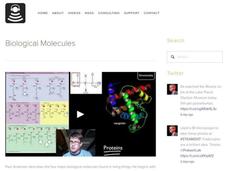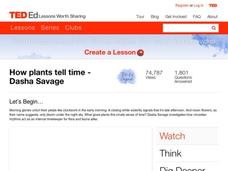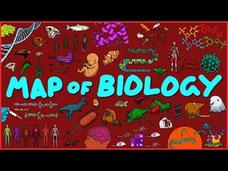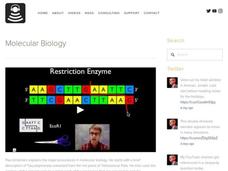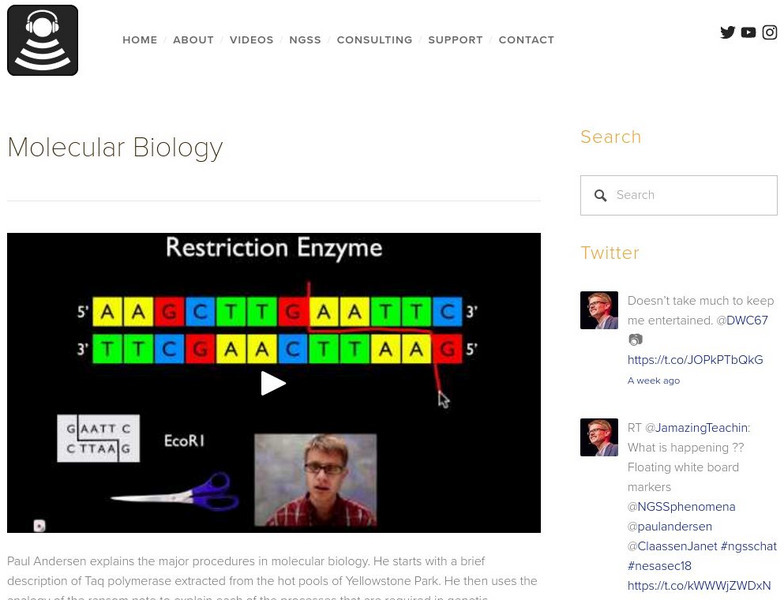Bozeman Science
Biological Molecules
Focus on macro-molecules including nucleic acids, proteins, lipids, and carbohydrates. A video explains which are monomers, which form polymers, and the process of changing from one to the other. It also covers the characteristics of...
TED-Ed
How Plants Tell Time
Can someone really have a "biological clock"? Discover why many organisms on earth have an inherent awareness of where they are in the day's cycle.This video discusses animal adaptations, the earth's revolutions, and how light and...
Howard Hughes Medical Institute
Chargaff's Ratio
How do we know the structure of DNA? Learn about Chargaff's rule and how scientists first discovered the structure of DNA. Using an informative video, young scientists identify how the arrangement of complementary nitrogen bases affects...
Domain of Science
The Map of Biology
Many define biology as the study of life but can't agree on a definition of life. Trying to explain all of the domains and subdomains of biology seems a bit easier than defining life. See a full map of the topics covered by the general...
American Chemical Society
The Nobel Prize in Chemistry: Molecular Machines, Explained
What does it take to win a Nobel Prize? Scholars learn about molecular machines, the theme of the 2016 Nobel Prize in Chemistry. It explains how the three winners have each contributed to this field of science.
Bozeman Science
The Origin of Life - Scientific Evidence
Guess where the oldest rocks on Earth are found? And what do these rocks reveal about the age of the earth? Viewers of this short video analyze the age of the earth and explore the origin of life through geologic,...
Bozeman Science
Molecular Biology
Explore the bacteria at Yellowstone to introduce molecular biology. Scholars learn about the process of genetic engineering and how it has progressed over time, including the identification of the breast cancer genes and the main...
TED-Ed
What Is the Biggest Single-Celled Organism?
Meet Caulerpa taxifolia, believed to be the largest single-celled organism in the world. How does it work and where is it found? Learn all about this invasive algae and why it is so successful.
Massachusetts Institute of Technology
Mit: Blossoms: Using Dna to Identify People
This lesson focuses on the molecular biology technique of DNA fingerprinting: what it is, how it works, and how the data from these experiments are used for paternity testing and forensics. [45:48]
PBS
Pbs Learning Media: Human Chromosome 2
In this video segment adapted from NOVA: "Judgment Day: Intelligent Design on Trial," students will learn how modern genetics and molecular biology offer compelling support for evolution. The video features an interview with biologist...
Other
Molecular Movies: Cell & Molecular Animation Showcase
An organized directory showcasing cell and molecular animations for use in high school biology classrooms.
Howard Hughes Medical Institute
Hhmi: Biointeractive: Viral Outbreak: The Polymerase Chain Reaction (Pcr)
Learn how a standard lab technique, polymerase chain reaction, amplifies a single or several copies of a piece of DNA. [0:55]
TED Talks
Ted: Ted Talks: David Bolinksky Animates a Cell
View this video that contains 3 minutes of amazing cel animation created by David Bolinsky. In the video he discusses the project that was designed for the Molecular and Cellular Biology Department at Harvard. Included is a complete...
Khan Academy
Khan Academy: Can We Clone Extinct Dinosaurs From Dna Preserved in Their Fossils
Paleontologists and molecular biologists have searched for a couple of decades to find and replicate DNA from some non-avian dinosaur fossil. [0:59]
Khan Academy
Khan Academy: Central Dogma Revisited
This video lesson is designed for Class 12 Biology (India). This video lesson explains how new discoveries have expanded or contradicted the original central dogma of molecular biology as proposed by Watson and Crick. These discoveries...
Khan Academy
Khan Academy: Central Dogma of Molecular Biology
This video lesson is designed for Class 12 Biology (India). This video lesson explains the central dogma of molecular biology, as explained by Watson and Crick.
PBS
Pbs: Spina Bifida Repair: Twice Born
In this video, learn how fetal surgeons can help repair a birth defect of the spine known as Spina Bifida.
Science Friday Initiative
Science Friday: Python Could Help Treat Heart Disease
Molecular biologist Leslie Leinwand discusses how a python's heart could help treat heart disease.
Bozeman Science
Bozeman Science: Molecular Biology
Paul Andersen explains the major procedures in molecular biology. He starts with a brief description of Taq polymerase extracted from the hot pools of Yellowstone Park. He then uses the analogy of the ransom note to explain each of the...
Bozeman Science
Bozeman Science: Ap Biology Lab 6 Molecular Biology
Paul Andersen explains the two major portions of the molecular biology lab in AP Biology. He starts by discussing the process of transformation. He explains how you can use the pGLO plasmid to produce glowing E. coli bacteria. He then...
